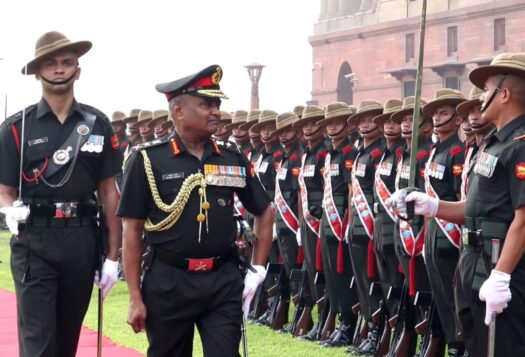
In October 2023, India deployed 140 AI-based surveillance systems along its northwestern border with Pakistan, signaling a concerning development in the militarization of AI. India has emerged as a significant player in the rapid advancement of AI technologies, as observed in its AI-enhanced weaponry and surveillance systems. While Pakistan has not officially confirmed that it uses AI and Machine Learning in its military weaponry and defenses, it has recently pushed funding toward new initiatives to utilize these technologies. Consequently, the potential of a regional arms race driven by technological advancements is intensifying, eroding the traditional boundaries between nuclear and conventional arms. The erosion of this boundary poses a heightened risk of nuclear escalation in a region already marked by instability. In this context, it is imperative to establish robust international regulations governing the military application of AI.
Such an initiative should implement bilateral confidence-building measures between India and Pakistan, including the development of a code of conduct for AI use in military operations, the promotion of Track-II diplomacy, and the establishment of dedicated communication channels for AI-related matters. These steps are essential to mitigate the risks associated with the militarization of AI and to foster a safer, more stable, international environment.
The potential of a regional arms race driven by technological advancements is intensifying, eroding the traditional boundaries between nuclear and conventional arms.
Development of AI for Military Purposes in South Asia
India has significantly advanced in AI-based weaponry, enhancing its military’s situational awareness and data interpretation. The 140 AI-based surveillance systems deployed on the border with Pakistan include high-resolution cameras, sensors, unmanned aerial vehicle feeds, and radar feeds. A key technological development in the last year is swarm drones that are capable of targeting nuclear bomb delivery systems.
The Artificial Intelligence Military Council, formed under the Military Minister in 2022, is pivotal in AI strategy, with a USD $12 million annual budget for the Defense AI Project Agency (DAIPA). In addition to the 30 maritime AI projects the Indian Navy developed in 2022, the DAIPA expects to develop 25 more AI military products by 2024.
India’s application of AI in its military strategy has significantly improved the synergy between its nuclear and conventional arsenals. AI-driven technology, such as swarm drones, enhances this synergy by improving the military’s real-time decision-making and situational awareness. While this marks a major advancement in India’s defense capabilities, it also introduces risks of misinterpretation and misunderstanding, particularly in the context of its relations with Pakistan. This could lead to unintended escalation, posing serious concerns for nuclear stability in the region.
According to a 2020 report by the Stockholm International Peace Research Institute, Pakistan’s AI military spending is minimal and the technologies are not indigenously produced. Still, recent developments show a shift in Pakistan’s priorities. In 2018, Pakistan allocated USD $1.67 million to the National Center of Robotics and Automation for three AI projects. The Pakistan Air Force (PAF) founded the Centre for Artificial Intelligence and Computing (CENTAIC) in August 2020, and in December 2020, launched a course on Cognitive Electronic Warfare. The PAF established CENTIAC in 2020 for AI research in civilian and military applications, focusing on big data, machine learning, deep learning, predictive analytics, and natural language processing. In 2022, the Pakistan Army formed the Army Centre of Emerging Technologies within the Cyber Command to intensively research AI’s role in cybersecurity. These initiatives aim to use AI and Machine Learning to enhance decision-making across Pakistan’s military and civilian sectors.

Impact of AI on Nuclear Stability
AI has the capability to sift through vast quantities of data from diverse sources, thereby locating strategic military objectives with increased precision. Mobile nuclear units, typically manifested as trains or trucks, are employed in the context of nuclear weapons to transport and, if necessary, launch nuclear missiles. These systems significantly enhance strategic flexibility and survivability by facilitating the mobility and camouflage of nuclear armaments. AI proficiency is particularly impactful in the realm of nuclear forces, especially mobile units. This technology enables a military to accurately predict the locations of these elusive targets, thereby reducing the likelihood of human error.
The precise targeting capabilities afforded by AI heighten the risk of nuclear escalation during crises. AI’s rapid data processing can also accelerate decision-making in high-stress scenarios. Thus, AI’s potential to expedite the targeting of mobile nuclear arsenals heralds a new era of swifter and more efficient military operations. However, this speed also raises the likelihood of hasty decisions based on limited information, potentially leading to misinterpretations and increased tensions. Pakistan, in close geographical proximity to India and compact in size, perceives this as a significant threat. In situations where leaders feel compelled to act swiftly, the nuclear threshold may be reduced as a consequence of AI.
The risk of inadvertent nuclear escalation is heightened by attribution challenges with Autonomous Weapons Systems (AWS). Frequent skirmishes along the Line of Control (LoC) between India and Pakistan make AWS deployment there particularly concerning. AWS misinterpreting military activities could quickly escalate to a nuclear crisis. Cybersecurity is also a critical risk factor, as AWS are vulnerable to hacking, heightening the unpredictability of Indo-Pakistan conflicts. Compromised AWS could inadvertently trigger military actions, complicating crisis management and potentially sparking a technological arms race in the region. Hence, the militarization of AI, particularly in the Indo-Pakistan context, requires a cautious approach to maintain strategic stability in South Asia.
Challenges such as political resistance, the delicate balance between transparency and security, and a reluctance to divulge AI developments for fear of strategic loss further complicate India and Pakistan’s ability to establish mutual standards.
The Need for AI-Specific Confidence Building Measures
The increasing utilization of AI in military domains, especially within the volatile India-Pakistan relationship, underscores an urgent need for bilateral dialogues. These conversations, straddling the scientific and political spheres, are crucial in mitigating the risks of nuclear escalation exacerbated by the militarization of AI. Central to these dialogues should be the dual aims of maintaining transparency while ensuring security, and establishing conduits for the exchange of AI knowledge to promote the ethical use of military AI.
Key to fostering understanding and communication are initiatives like seminars, training programs, and establishing risk reduction centers. The creation of incident reporting systems and the development of crisis communication strategies tailored to AI-specific scenarios are equally vital. Furthermore, engaging in Track II diplomacy and formulating international norms will be instrumental in diminishing nuclear risks. These dialogues must confront the perils, unforeseen consequences, and ethical dilemmas posed by military AI. In parallel, conversations on conventional arms control are imperative to alleviate regional tensions and prevent misunderstandings, particularly given India’s advancements in AI weaponry.
Tackling the risks associated with AI in the military dynamics of India and Pakistan is inherently complex due to deep-seated mistrust, which impedes open discussions on the military’s use of AI. Challenges such as political resistance, the delicate balance between transparency and security, and a reluctance to divulge AI developments for fear of strategic loss further complicate the countries’ ability to establish mutual standards. The disparities in technical capabilities might also amplify distrust. Additional hurdles include defining incidents and verifying information in AI-related emergencies, compounded by the lack of a global regulatory authority for military AI ethics.
Integrating AI into arms control dialogues necessitates a deep understanding of both traditional and AI-enhanced weaponry, a process often hampered by gaps in technical knowledge. Aligning confidence-building measures with national economic and strategic interests presents its own set of challenges. Addressing these issues requires sustained diplomatic engagement, technical collaboration, continuous dialogue, and international cooperation. Such efforts are essential to strike a balance between national interests and the imperatives of risk reduction.
Also Read: AI-Powered Influence Operations and South Asian Fault Lines
***
Image 1: India-Pakistan Border at Night via Wikimedia Commons
Image 2: Artificial Intelligence via Wikimedia Commons


